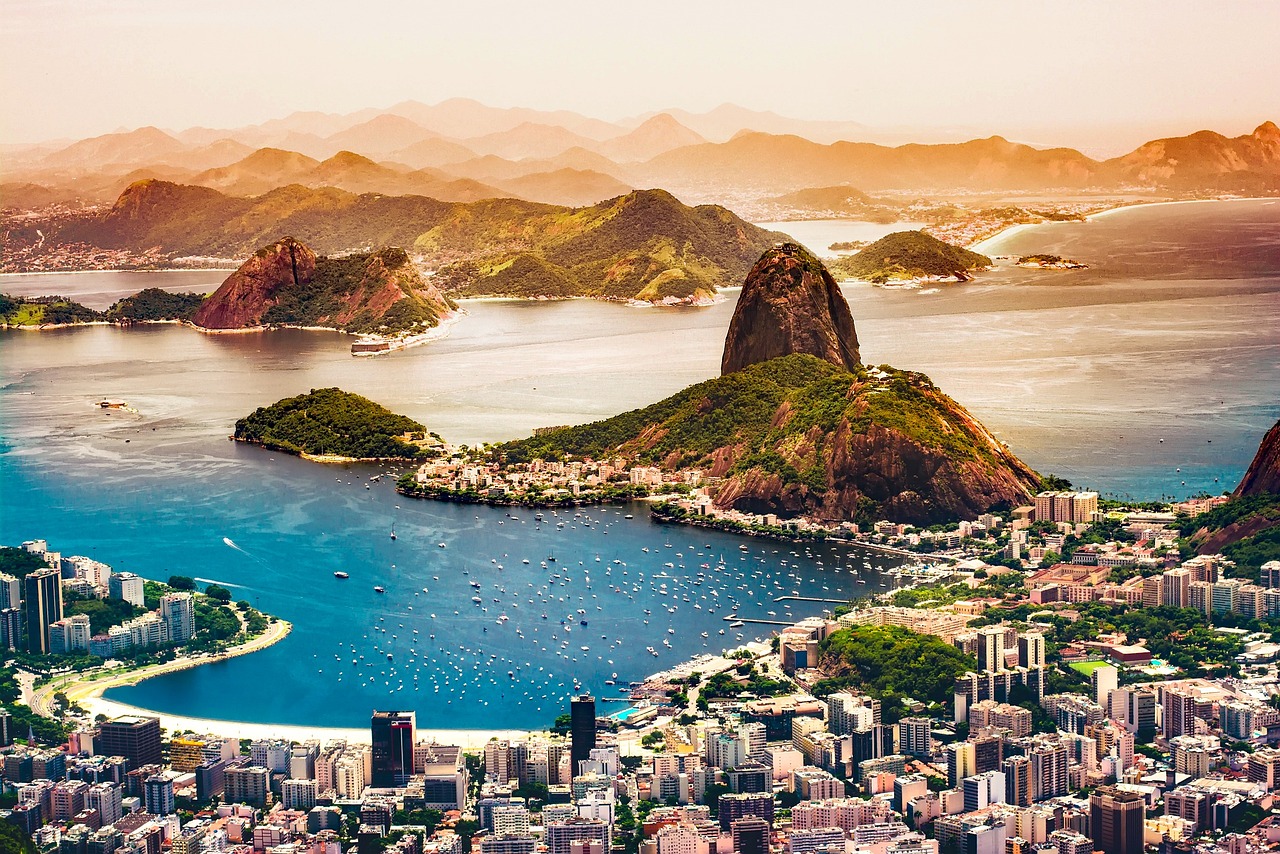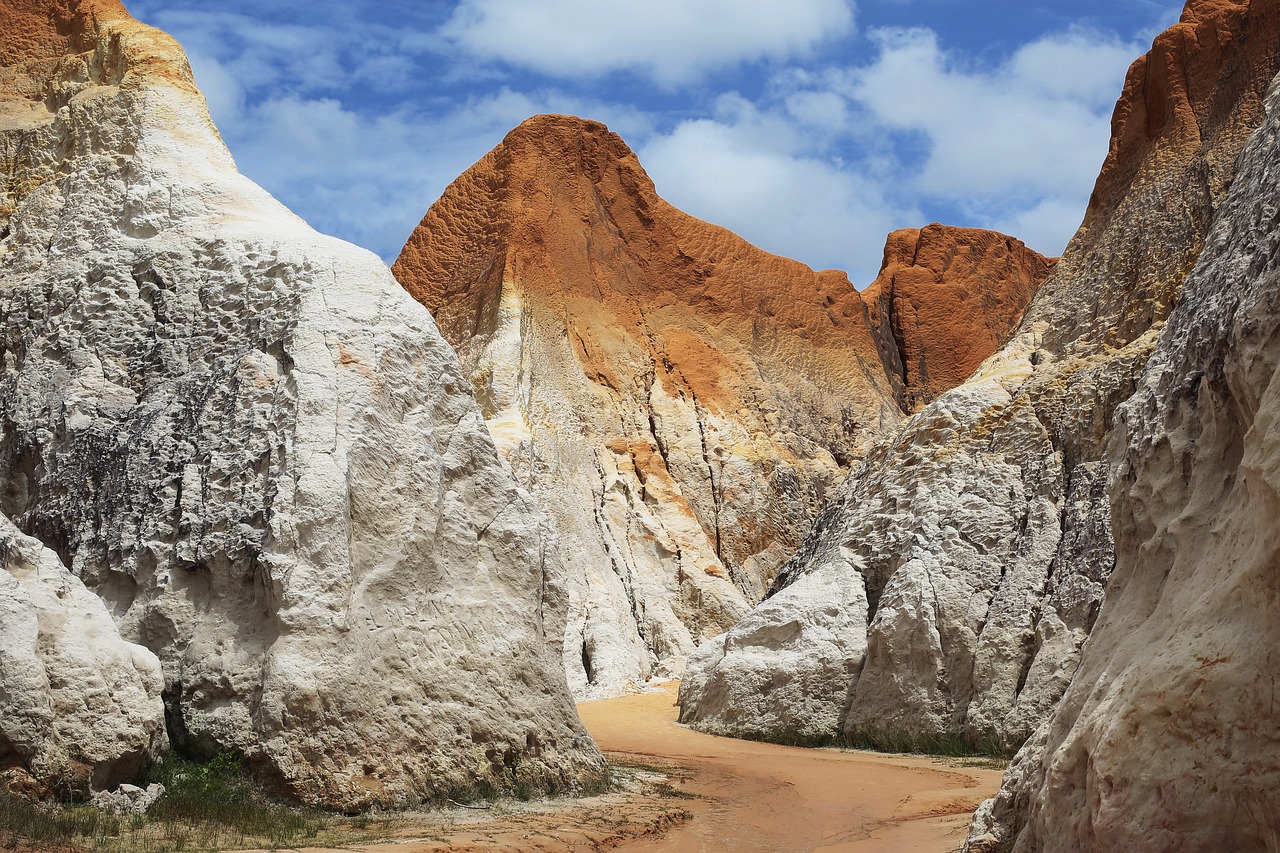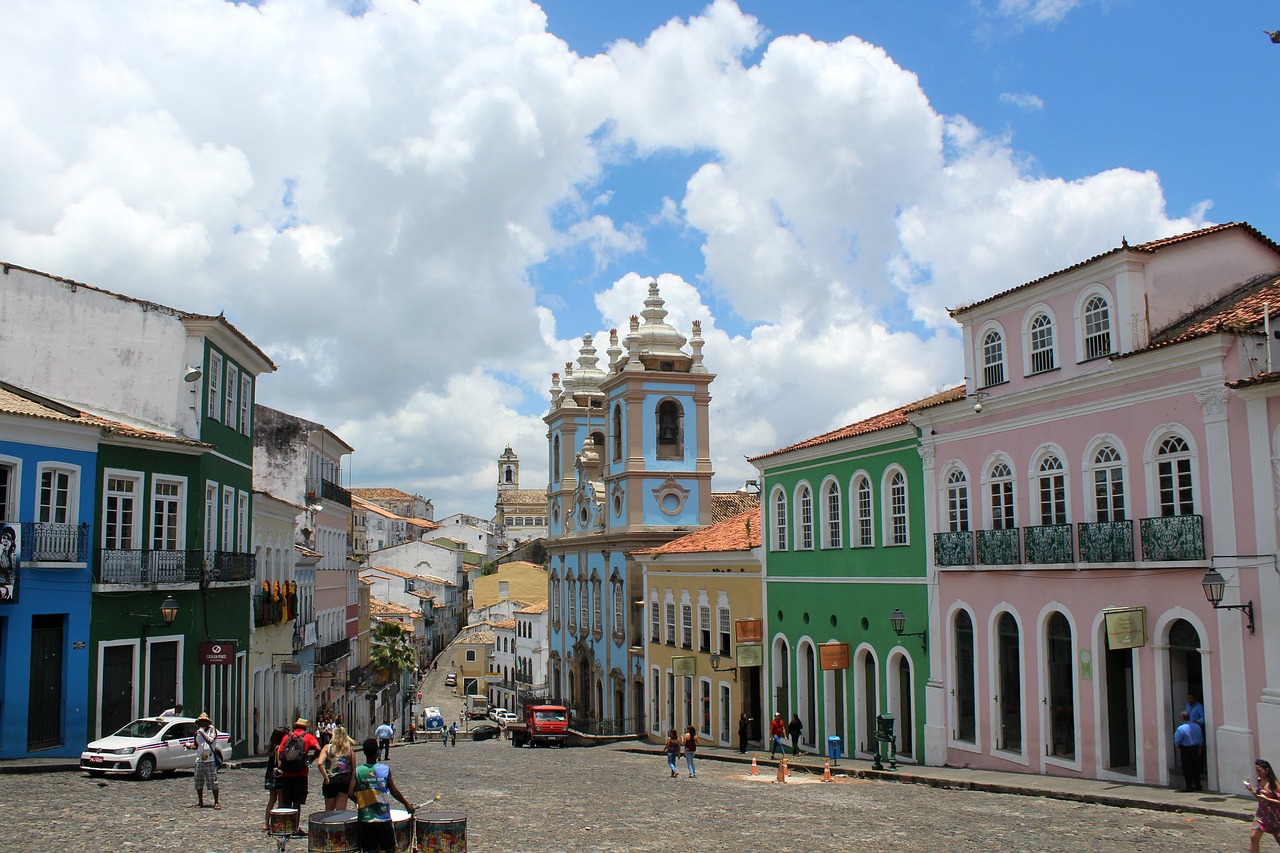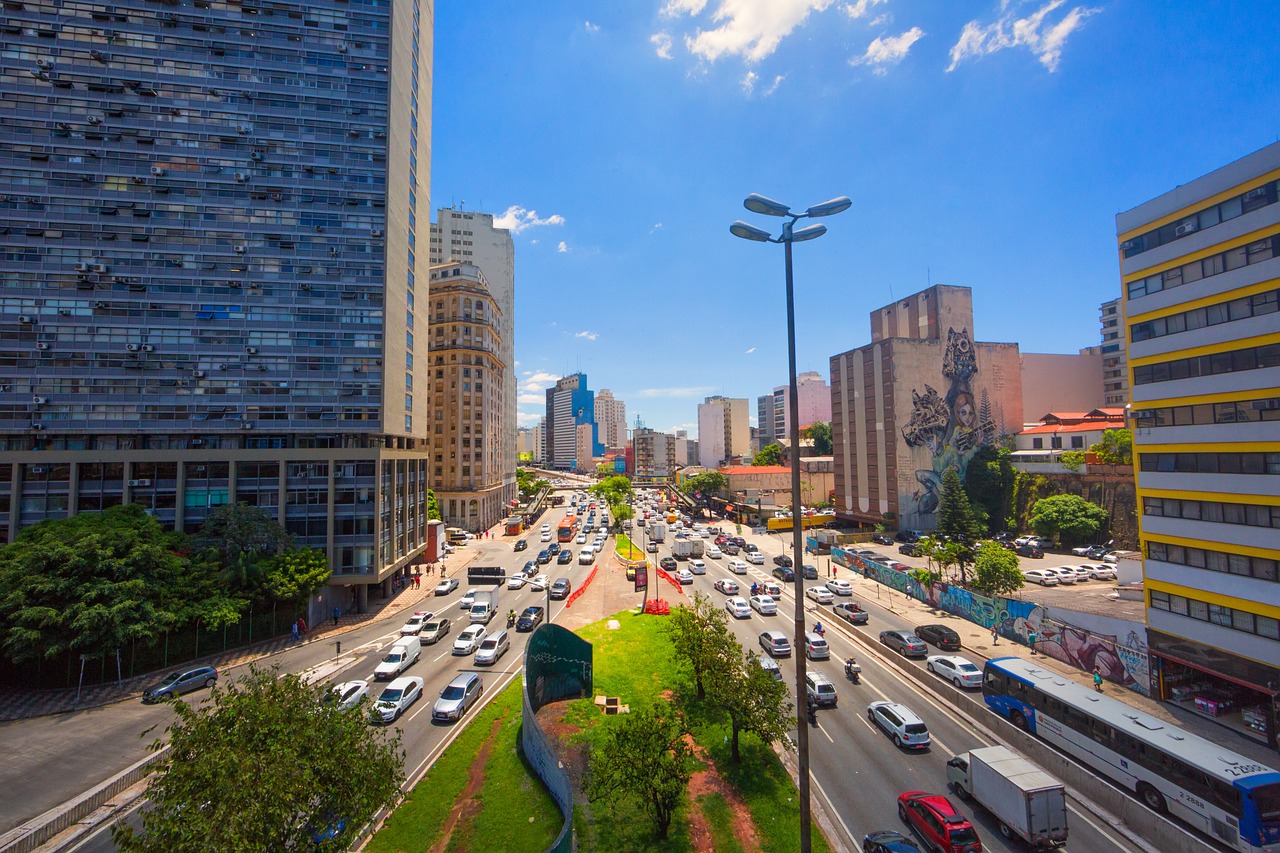Rio de Janeiro is a city located in the southeastern region of Brazil, along the Atlantic coast. It is the second-most populous city in Brazil and is known for its stunning beaches, natural landmarks, and vibrant culture.
Short History
Rio de Janeiro is a coastal city located in Brazil, known for its stunning beaches, vibrant culture, and annual carnival celebration. The city was founded in 1565 by Portuguese explorers, and for centuries it was the capital of Brazil until that title was passed to Brasília in 1960. The city played a significant role in the country’s independence movement in the early 19th century and has since become one of Brazil’s most popular tourist destinations, attracting millions of visitors from around the world each year.
Architecture
Rio de Janeiro is known for its diverse and eclectic architecture. It has a mix of colonial, Art Deco, modernist, and contemporary architecture styles.
One of the most famous architectural landmarks in Rio de Janeiro is the Cristo Redentor, or Christ the Redeemer, statue that sits atop Corcovado Mountain overlooking the city. The statue was completed in 1931 and has become a symbol of the city.
Other notable examples of architecture in Rio de Janeiro include the Municipal Theater, which was inspired by the Paris Opera and completed in 1909; the Candelária Church, a Neoclassical-style church completed in 1898; and the Niterói Contemporary Art Museum, a futuristic-looking building designed by architect Oscar Niemeyer and completed in 1996.
There are also many historic neighborhoods in Rio de Janeiro, such as Santa Teresa, which is known for its colorful colonial architecture, and the Lapa neighborhood, which is famous for its arches and historical aqueduct.
Museums and Galleries
Here are some of the most interesting museums and galleries in Rio de Janeiro:
- Museum of Tomorrow – a science museum with interactive exhibits and displays about the future of the planet
- Rio Art Museum (MAR) – a contemporary art museum located in the historic port area of Rio de Janeiro
- National Museum of Fine Arts – a museum featuring Brazilian and international art collections, including works by Rembrandt and Rodin
- Museum of Modern Art – a museum with collections of modern and contemporary art, including works by Brazilian artists such as Tarsila do Amaral and Lygia Clark
- Carmen Miranda Museum – a museum dedicated to the life and career of the famous Brazilian singer and actress
- Casa Roberto Marinho – a museum located in a beautiful mansion that features a collection of art, antiques, and decorative arts
- Chácara do Céu Museum – a museum with a collection of Brazilian and international modern art, housed in a beautiful mansion with stunning views of the city and the bay
- Museu Histórico Nacional – a museum with exhibits about the history of Brazil, including artifacts, documents, and art from different periods of Brazilian history
- Casa Daros – a museum with a collection of contemporary art from Latin America, including works by artists from Brazil, Cuba, and other countries in the region
- Museu da Imagem e do Som (MIS) – a museum dedicated to the history and culture of Brazilian cinema and music, with exhibits, screenings, and events showcasing the best of Brazilian audiovisual culture.
These museums and galleries offer a diverse range of exhibits and collections, from contemporary art to historical artifacts, and provide visitors with a unique insight into Brazilian culture and history.
Landmarks and Monuments
- Christ the Redeemer – one of the most iconic landmarks in Rio de Janeiro, the statue of Christ the Redeemer stands tall at the top of Corcovado mountain, overlooking the city.
- Sugarloaf Mountain – another famous landmark in Rio de Janeiro, Sugarloaf Mountain is a granite peak that rises over 1,000 feet above Guanabara Bay.
- The Selaron Steps – also known as the Escadaria Selarón, this vibrant set of steps is covered in colorful tiles and connects the neighborhoods of Santa Teresa and Lapa.
- The Rio de Janeiro Cathedral – officially named the Metropolitan Cathedral of Saint Sebastian, this unique circular cathedral has a modern design and can seat up to 20,000 people.
- The National Museum of Brazil – located in Rio’s Quinta da Boa Vista Park, the National Museum of Brazil houses a vast collection of artifacts, including mummies, fossils, and indigenous art.
- Maracanã Stadium – one of the world’s largest football stadiums, Maracanã Stadium has hosted many major sporting events, including the 2014 World Cup final.
- The Royal Portuguese Cabinet of Reading – a stunning library with ornate architecture and a collection of over 350,000 books, including rare and ancient works.
- The Museum of Tomorrow – a futuristic museum that explores the impact of science and technology on the future of our planet.
- The Candelária Church – an impressive church with a neoclassical façade and ornate interior, located in Rio’s historic downtown.
- Fort Copacabana – a military fort located on the beach of Copacabana, now turned into a museum, offering panoramic views of the coastline and the city.
Parks and Green Spaces
Here are some of the most popular parks and green spaces in Rio de Janeiro:
- Tijuca National Park: This is the largest urban forest in the world and offers hiking trails, waterfalls, and stunning views of the city.
- Jardim Botânico: This botanical garden is home to over 8,000 species of plants and flowers, as well as a bird sanctuary and several greenhouses.
- Parque Lage: Located at the foot of Corcovado Mountain, this park is home to a historic mansion, several gardens, and a small lake.
- Flamengo Park: This park is located along the waterfront and features bike paths, sports fields, and a marina.
- Quinta da Boa Vista: This park was once the home of the Brazilian imperial family and now features a zoo, botanical garden, and several museums.
- Lagoa Rodrigo de Freitas: This lagoon is surrounded by a jogging and biking path and offers paddle boating, rowing, and fishing.
- Pedra da Gávea: While not a traditional park, this massive rock formation offers hiking trails and stunning views of the city and the ocean.
- Parque do Flamengo: This park is a popular spot for picnics, soccer games, and outdoor concerts.
- Bosque da Barra: This park is located in the Barra da Tijuca neighborhood and offers hiking trails, a lake, and several sports fields.
- Passeio Público: This is Rio’s oldest park, dating back to 1783, and features a small zoo, a lake, and several gardens.
These are just a few examples of the many parks and green spaces in Rio de Janeiro. The city is known for its natural beauty, and there are plenty of opportunities to enjoy it through outdoor activities and recreation.
Shopping Districts
Rio de Janeiro has a variety of shopping districts that offer different experiences for shoppers. Here are some of the most popular ones:
- Ipanema: Known for its luxurious boutiques, Ipanema is a great place to find high-end fashion and jewelry. The Rua Garcia d’Ávila is a popular street for shopping, where you can find stores like H. Stern and Le Lis Blanc.
- Copacabana: Copacabana has a more laid-back vibe than Ipanema, but it still offers plenty of shopping options. Avenida Nossa Senhora de Copacabana is a bustling street with stores selling everything from clothing to souvenirs.
- Saara: The Saara neighborhood is known for its street markets and bargain shopping. Here, you can find anything from clothing to electronics to household goods.
- Leblon: Similar to Ipanema, Leblon offers upscale shopping options. The Shopping Leblon mall is a popular spot for luxury brands like Louis Vuitton and Prada.
- Centro: The Centro neighborhood has a mix of high-end and budget-friendly shopping options. The Rua Uruguaiana is a popular street for bargain shopping, while the Rua do Ouvidor has more upscale stores like Saraiva and Livraria Cultura.
- Barra da Tijuca: Located in the western part of the city, Barra da Tijuca is home to several shopping malls, including the BarraShopping and VillageMall. These malls offer a mix of high-end and mid-range stores.
- Niteroi: Across the bay from Rio de Janeiro is the city of Niteroi, which has its own shopping district. The Plaza Shopping Niteroi is a large mall with stores like Zara and Calvin Klein, while the Caminho Niemeyer complex offers shopping and cultural attractions.
- Santa Teresa: This bohemian neighborhood has a variety of artisanal shops and boutiques selling handmade crafts and clothing. The Largo dos Guimarães is a popular spot for shopping in Santa Teresa.
- Gavea: The Shopping da Gavea is a popular mall in this neighborhood, offering a mix of international and Brazilian brands like Adidas, Calvin Klein, and Osklen.
- Lapa: This neighborhood is known for its nightlife, but it also has a few shopping options. The Feira da Lapa is a weekly market selling clothing, accessories, and souvenirs, while the Rua do Lavradio has several vintage stores and antique shops.
Food and Drink
Rio de Janeiro is known for its rich and diverse cuisine, influenced by African, European, and indigenous cultures. Here are some of the must-try food and drinks in Rio de Janeiro:
- Feijoada – A traditional Brazilian stew made with black beans and meat, usually served with rice, oranges, and farofa (toasted manioc flour).
- Pão de queijo – Small, cheese-filled bread rolls that are crispy on the outside and soft on the inside.
- Brigadeiro – A popular Brazilian dessert made with condensed milk, chocolate powder, and butter, rolled into small balls and covered in chocolate sprinkles.
- Caipirinha – Brazil’s national cocktail made with cachaça (sugar cane rum), lime, and sugar.
- Açaí – A purple berry from the Amazon, served as a frozen dessert topped with granola, fruit, and honey.
- Coxinha – A deep-fried snack made with chicken and dough, usually shaped like a teardrop.
- Churrasco – Brazilian barbecue, where meat is cooked on skewers over open flames.
- Quindim – A small, golden-yellow cake made with egg yolks, sugar, and coconut.
- Guarana – A carbonated soft drink made with the guarana berry, which is native to the Amazon.
- Pastel – A crispy pastry filled with meat, cheese, or vegetables, usually served as a snack or appetizer.
These are just a few of the many delicious foods and drinks to try in Rio de Janeiro. Don’t be afraid to explore the city’s vibrant food scene and try something new!
Transportation
Rio de Janeiro offers a variety of transportation options to move around the city, including:
- Metro: Rio de Janeiro has two metro lines that cover most of the city’s main tourist areas and are relatively cheap and safe.
- Bus: Buses are the most common mode of transportation in Rio de Janeiro, and the city has an extensive bus network that covers most of the areas.
- Taxis: Taxis are widely available in Rio de Janeiro and can be easily hailed on the streets or through taxi apps.
- Ride-hailing apps: Uber, Cabify, and other ride-hailing apps operate in Rio de Janeiro and are often cheaper and more convenient than traditional taxis.
- Bike-sharing: Rio de Janeiro has a bike-sharing program called Bike Rio, which offers an affordable and eco-friendly way to explore the city.
- Walking: Many of Rio de Janeiro’s top attractions are located in compact areas, making walking a great way to explore the city while enjoying its beautiful scenery.
City Safety
Rio de Janeiro can be both safe and unsafe depending on the area and time of day. Like many big cities, it has its share of crime and safety concerns, particularly in some of the more impoverished areas. Tourists should take the same precautions they would take in any big city, such as being aware of their surroundings and avoiding deserted areas at night. In general, the more touristy areas of the city are considered safe, but it’s always a good idea to check with locals or your hotel staff for safety recommendations.
Expensive or Cheap
Rio de Janeiro can be considered a relatively expensive city, especially when compared to other cities in Brazil. However, the cost of living can vary greatly depending on the neighborhood, type of accommodation, and lifestyle choices. Overall, it is possible to find affordable options for food, transportation, and entertainment in Rio de Janeiro.
Best Time to Travel
The best time to travel to Rio de Janeiro is between December and March, which is summer in the Southern Hemisphere. During this time, the weather is warm and sunny, making it perfect for beach activities and outdoor adventures. Additionally, this is when the famous Carnival festival takes place, attracting tourists from all over the world. It is important to note that prices can be higher during this peak season, so it’s recommended to book in advance.
Date Ideas
Rio de Janeiro is a city with a vibrant and romantic atmosphere, making it a perfect destination for a romantic getaway. Here are some date ideas in Rio de Janeiro:
- Watch the sunset from Arpoador Rock – This is a popular spot for watching the sunset, where you can enjoy stunning views of Ipanema and Copacabana beaches.
- Take a cable car ride to Sugarloaf Mountain – The cable car ride to the top of Sugarloaf Mountain is a must-do activity in Rio de Janeiro. You can enjoy panoramic views of the city and watch the sunset with your loved one.
- Stroll through the Botanical Garden – This beautiful garden is home to over 6,500 species of plants, including rare orchids and bromeliads. It’s a peaceful oasis in the heart of the city and perfect for a romantic stroll.
- Visit the Christ the Redeemer Statue – The iconic Christ the Redeemer statue is one of the most famous landmarks in Rio de Janeiro. You can take a train or hike to the top of the mountain and enjoy breathtaking views of the city.
- Explore the historic streets of Santa Teresa – This bohemian neighborhood is full of colorful streets, art galleries, and cozy cafes. It’s a great place to wander around and soak up the local culture.
- Take a sunset sail on Guanabara Bay – There are many companies that offer sunset sailing tours on Guanabara Bay. It’s a romantic way to enjoy the beautiful views of Rio de Janeiro from the water.
- Enjoy live music at a samba club – Rio de Janeiro is famous for its samba music and dance. There are many clubs where you can enjoy live music and dance the night away.
- Take a helicopter tour – For a truly unforgettable experience, you can take a helicopter tour of Rio de Janeiro. It’s a unique way to see the city and perfect for a special occasion.
- Relax on the beach – Rio de Janeiro has some of the most beautiful beaches in the world. You can spend the day soaking up the sun and swimming in the ocean with your loved one.
- Visit the Lapa Steps – The Lapa Steps are a colorful staircase covered in tiles and mosaics. It’s a unique and quirky attraction in Rio de Janeiro and a great spot for a photo-op.
Fun and Interesting Facts
Fun and interesting facts about Rio de Janeiro:
- Rio de Janeiro is known for its Carnival, a huge festival that takes place every year before Lent, attracting millions of people from around the world.
- The city is home to one of the world’s most famous landmarks, the Christ the Redeemer statue, which stands 98 feet tall atop Corcovado Mountain.
- Rio de Janeiro is surrounded by lush mountains and rainforests, including Tijuca National Park, the largest urban forest in the world.
- The city has some of the world’s most famous beaches, including Copacabana and Ipanema, which are popular with tourists and locals alike.
- Rio de Janeiro is known for its street art, with colorful murals and graffiti decorating the walls of many buildings throughout the city.
Conclusion
Rio de Janeiro is a vibrant and exciting city with a rich cultural heritage and stunning natural beauty. From its iconic landmarks and world-famous beaches to its lively street art scene and annual Carnival festival, there is always something new and exciting to discover in Rio de Janeiro. While the city does face some challenges with safety and economic inequality, it remains a popular destination for tourists and a source of pride for its residents.



